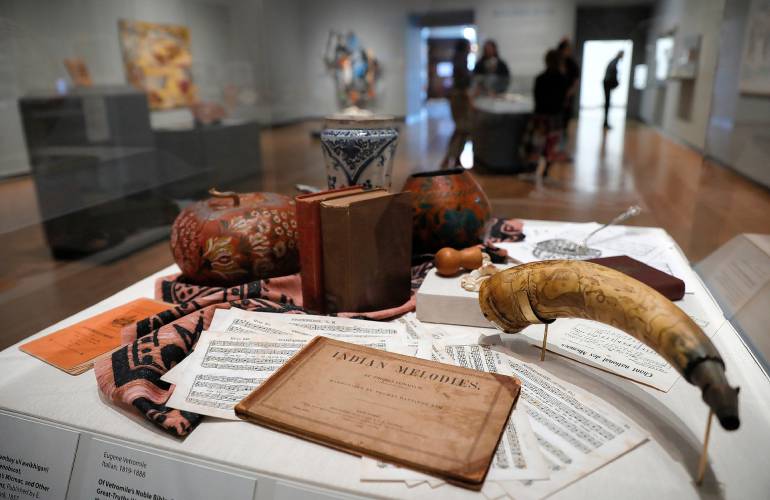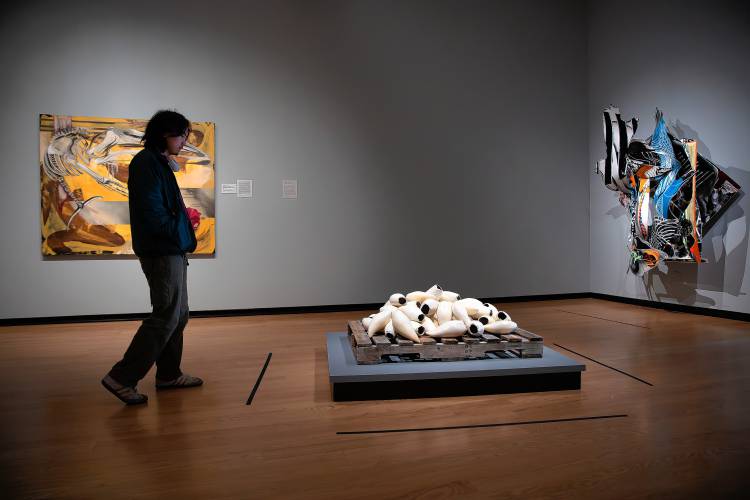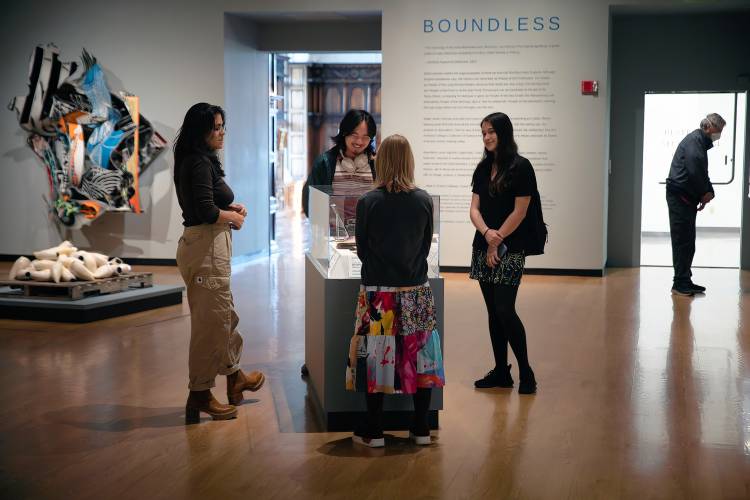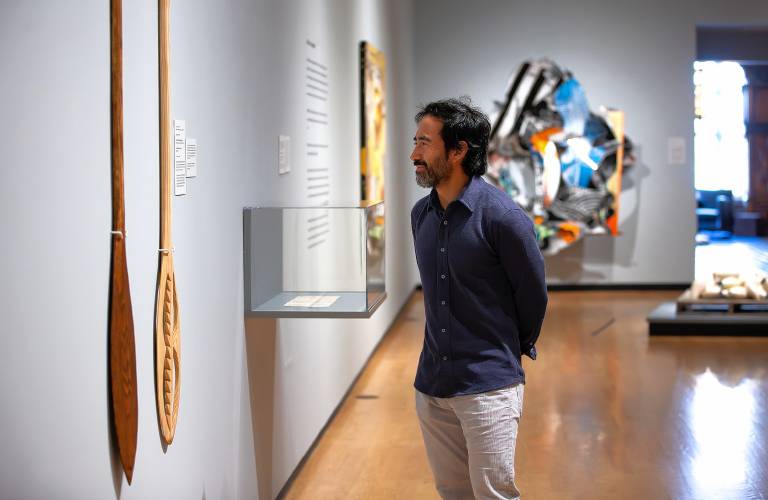By STEVE PFARRER
Staff Writer
From the pages of a 17th century Algonquin-language Bible, to a 2021 painting that celebrates the majesty of whales, a new exhibit at the Mead Art Museum at Amherst College devoted to Native American art is built around the theme of water.
“Boundless” features work by more than 150 Native American artists and writers — sculpture, prints, paintings, basketry, historic and contemporary writing — with some materials in the exhibit going back over three centuries.

“Boundless” features a wide range of work by Native American writers and artists, including sculpture, traditional crafts, and writing that in some cases dates back over three centuries. STAFF PHOTO/DAN LITTLE
Designed to recognize “Indigenous creativity, resistance and persistence,” as exhibit notes put it, the show also represents a close collaboration between the Mead Museum and Amherst College’s Archives & Special Collections, which has an extensive collection of Native American literature.
And as curator Heid E. Erdrich sees it, the materials in the exhibit flow together in a way that makes connections between past and present, and between many of the Native people whose work is represented in the show.
“I was struck by how many of the names of Native people in the East are connected to water,” said Erdrich, a poet, writer, and educator from Minnesota. A member of the Objibwe people, Erdrich also has a deep background in curating Native American art exhibitions.
As Erdrich writes in exhibit notes, the Nipmuc “are described as People of the Freshwater; the Niantic as People of the Long-Necked Waters because their lands are near a bay; the Narragansett are People of the Point or of the Salt Pond; Shinnecock can be translated to People of the Stony Shore.”
The winner of two Minnesota Book Awards and a number of other writing honors, Erdrich comes from a family with impressive literary credentials: One of her sisters is Louise Erdrich, the acclaimed novelist, and another, Angela Erdrich, illustrates children’s books.

Student Ziji Zhou checks out some of the artwork in “Boundless” at the Mead Art Museum. From left are works “Collider Study #1” and “BREACH #2” by Courtney Leonard; at right is “Of Whales in Paint, in Teeth, &c.” by Frank Stella. STAFF PHOTO/DAN LITTLE
In a recent phone call from her home in Minneapolis, Heid Erdrich said “Boundless” is the most extensive exhibit she’s ever worked on, but a rewarding one nevertheless, given the deep reservoir of material she was able to draw on, especially from the college, which acquired a large collection of Native American writing in 2013 and has since added to it.
“As a writer, it was fascinating to be able to see this material,” said Erdrich, who began her research on the exhibit in 2020, during the height of the pandemic, with a deep online dive into the Amherst collection.
Lisa Crossman, the Mead’s director of curatorial affairs, says the museum has a fairly small collection of Native American art. But after talking with professors such as Lisa Brooks and Kiara Vigil, who teach Native American studies at Amherst, and Mike Kelly, the head of the college’s Special Collections department, she realized the Mead could create an exhibit that combined art and writing.
“The exhibit is really about looking at the connections between many of these materials,” she said during a recent tour of the gallery.
“Boundless” relies on some loans from other Northeast collections and a few further afield. The exhibit predominantly features work from eastern Indigenous people; an advisory committee including members from the Nipmuc, Wampanoag, Shinnecock and Mohegan Tribal Nations, among others, assisted in development.
“A big part of my work in 2021 was meeting Indigenous people from Massachusetts and other parts of the East and getting their input,” said Erdrich, who’s spent some previous time in New England and Massachusetts (she’s a graduate of Dartmouth College). “That was really important to me.”
Of whales and more
“Boundless” integrates its work by theme and feel rather than presenting material chronologically or by medium. In the Mead’s main gallery, contemporary paintings and sculpture share space with aged documents and books by Indigenous authors, such as an 1887 volume, “History of the Ottawa and Chippewa Indians of Michigan,” with birchbark binding and decoration made from porcupine quills.
Also on view is “Collider Study #1,” a large mixed-media and acrylic painting from 2021 by Courtney Leonard (Shinnecock) that depicts the skeletal remains of a humpback whale killed off the coast of New England in 2007 when it was stuck by a fishing boat.

Amherst College K-12 Program Manager Olivia Feal, left, students Ziji Zhou and Kalea Ramsey, and Curatorial Affairs Director Lisa Crossman (seen from behind) view part of the exhibit “Boundless” at the Mead Art Museum at Amherst College. STAFF PHOTO/DAN LITTLE
In an artist’s note, Leonard says the painting, which includes a red poppy — a symbol of rebirth and healing — reflects how “pain and loss can also lead to healing and continuity,” while also noting that a whale “would traditionally feed the entire Shinnecock Nation during harsh times.”
Near Leonard’s painting, meantime, is a colorful sculpture by Frank Stella, “Of Whales in Paint, in Teeth, &c.,” made of large shards of painted aluminum. According to exhibition notes, Stella based the 1990 work on a chapter from Herman Melville’s “Moby Dick” in which Native, white and ancient people alike are described as savage.
This and a few other non-Native artworks have been added to “Boundless” to provide additional context. As one example, there’s an 1855 painting of the Connecticut River, as viewed from Mount Holyoke, by Edmund C. Coates, a New York artist connected with the Hudson River School of painting.
In exhibit notes, Erdrich says the painting, while capturing a beautiful and peaceful scene, can pose a problem for Native viewers — how can they look at it and not think of Indigenous people who lived along the Connecticut “and were driven from their homelands in the years just before this image was made?”
Other sections of the exhibit showcase work by artists who share some links, such as the Dakota, Lakota, Hochunk and other Great Plains groups that can be linked culturally or biologically.
That includes work by Mary Sully, a Dakota artist of the early/mid 20th century whose paintings and illustrations won attention for the way she merged classic Native American designs with Art Nouveau and other abstract forms.

Ernesto Monter views white ash canoe paddles made by artist and carver Jonathan James-Perry in “Boundless,” an exhibit of Native American art and writing at Amherst College’s Mead Art Museum. STAFF PHOTO/DAN LITTLE
In one of the exhibit’s grimmer connections, it’s noted that Sully was related to Alfred Sully, a 19th century American painter and Army officer who took part in massacres of Plains Indians in the 1860s and 1870s and at one point was married to a Dakota woman.
Alfred Sully was in turn a son of Thomas Sully, a noted painter in the early 19th century who produced portraits of Thomas Jefferson, John Quincy Adams, and Andrew Jackson, among others. Mary Sully was a great-granddaughter of Thomas Sully.
“The connections in this exhibit run along some very deep and surprising lines,” said Crossman.
Accompanying “Boundless” is a smaller exhibit, “Seeping In,” by fiber artist and jewelry designer Elizabeth James-Perry (Aquinnah Wampanoag), a former artist-in-residence at the college. It features necklaces and other works for which James-Perry has drawn in part on ancestral traditions of the Connecticut River valley.
“Boundless” runs through Jan. 7, 2024 and will be followed by a smaller version of the exhibit in the spring “so we can show some of the materials we couldn’t fit in this exhibit,” Erdrich said with a laugh. “There is so much to share.”
Heid E. Erdrich will gave a gallery talk at “Boundless” on Oct. 12.



